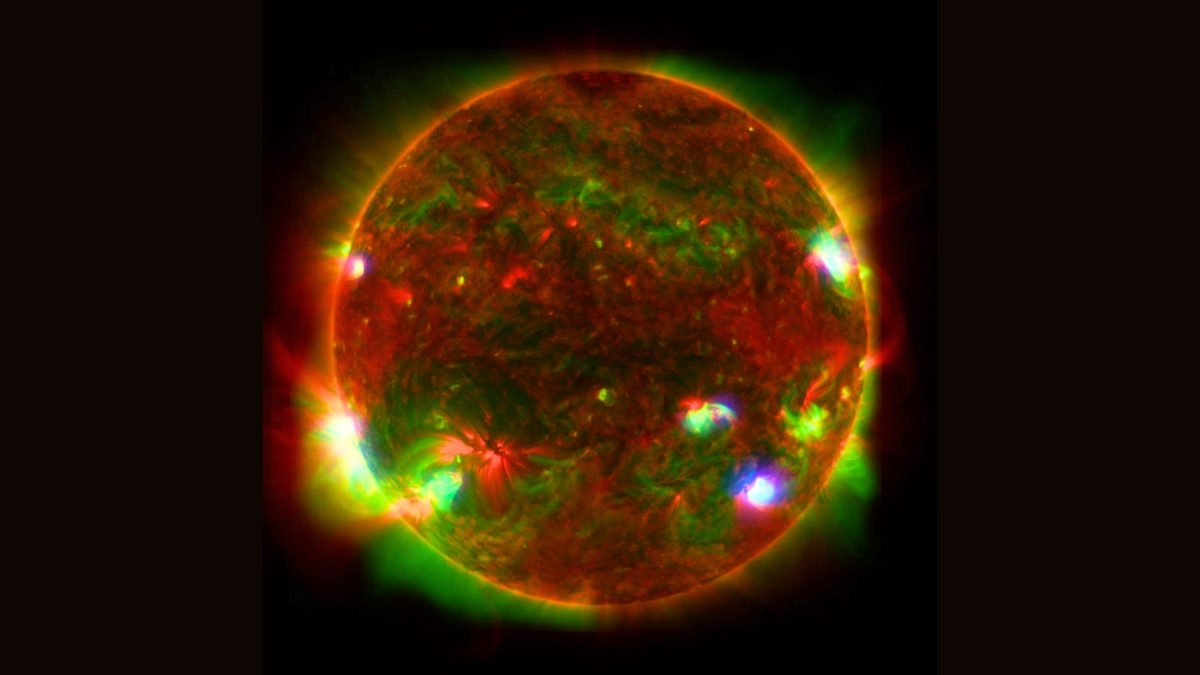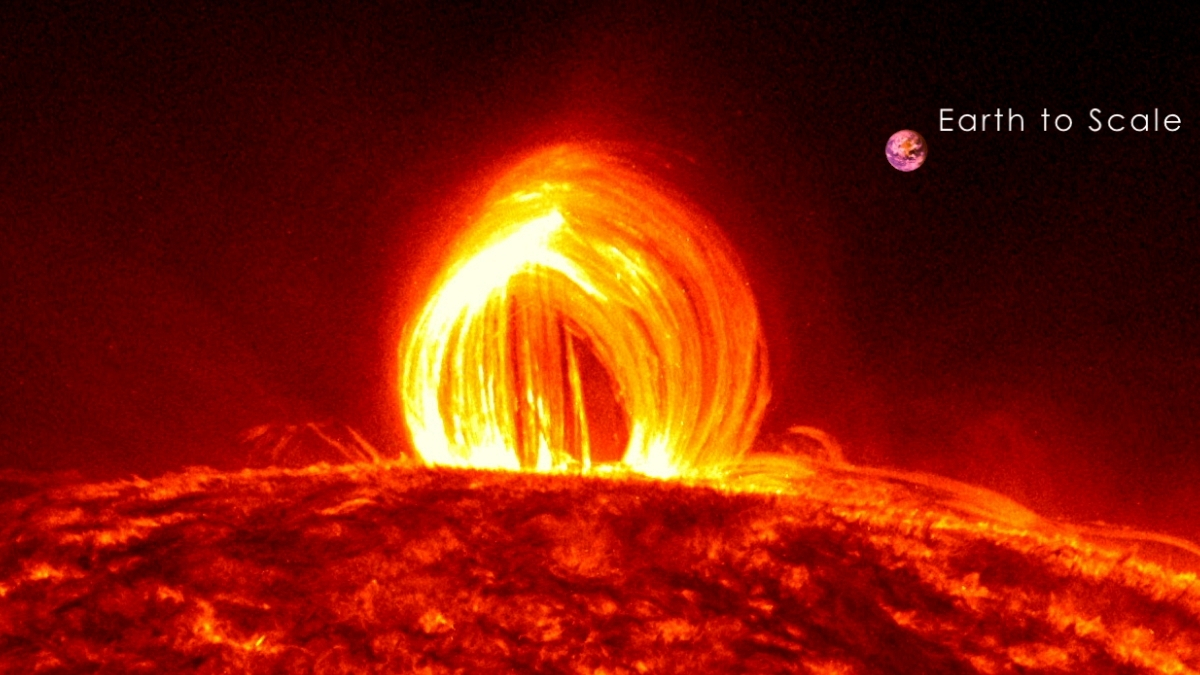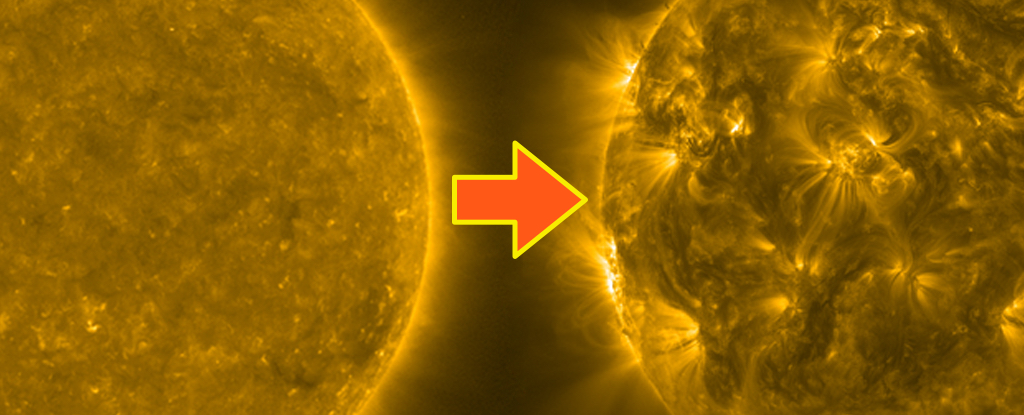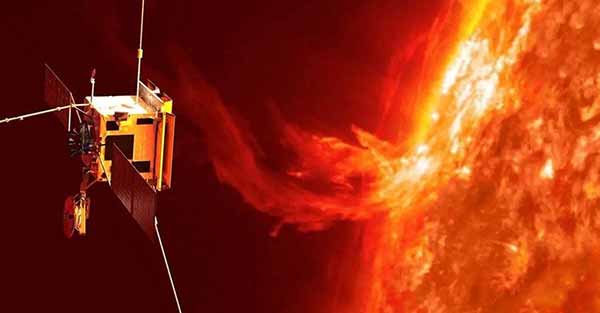
There Are Colors Missing From The Sun - And We Still Can't Fully Explain Why. Science Alert - December 17, 2025

With decades of high-resolution solar spectroscopy, there are some spectral lines whose origins have never been clearly identified.
The Mystery of Rain on The Sun Can Finally Be Explained Science Alert - October 25, 2025

It rains on the Sun, the gigantic thermonuclear orb that burns with the multi-million-degree 'fires' of fusion. This rain is made of superheated plasma, and researchers might have discovered its secret: quickly shifting flows of elements such as iron, silicon, and magnesium.
After 70 years, the Sun's explosive mystery is finally solved about the process that releases stored magnetic energy to drive solar flares, coronal mass ejections and other space weather phenomena Science Daily - August 20, 2025

NASA's Parker Solar Probe has directly observed magnetic reconnection in the Sun's atmosphere for the first time, confirming decades-old theories about solar explosions.
Bottom of the sun becomes visible to humans for the first time in history (photos) Live Science - June 12, 2025

Pink 'raindrops' on the sun captured in greatest detail ever Live Science - June 1, 2025

Solar "raindrops" - plasma streams and vast arches extending outward from the sun's surface and into the corona, the outermost part of the solar atmosphere - have been captured in spectacular new detail by a ground-based telescope in California. Among the images taken from time-lapse movies, which utilize new technology to eliminate blurring caused by Earth's atmosphere, is coronal rain, a phenomenon that occurs when cooling plasma condenses and falls back toward the sun's surface along magnetic field lines.
Watch eerie 'UFOs' and a solar 'cyclone' take shape in stunning new ESA video of the sun Live Science - April 1, 2025

A newly released video has revealed a gigantic plume of solar wind towering above the sun in a never-before-seen, "cyclone-like" configuration that emerged in the wake of a massive solar explosion. The striking timelapse footage also captured strange lines streaking across the fiery scene like pixelated UFOs - but are actually distant stars.
Mysterious Radiation Belts Detected Around Earth After Epic Solar Storm Science Alert - February 7, 2025

In May 2024, an epic solar storm rattled Earth so powerfully that its effects were felt even at the bottom of the ocean. In the wake of a torrent of flare activity on the Sun, our planet was buffeted by a powerful blast of solar particles that shook our magnetic field, and bathed our skies with a panoply of shimmering colors as auroras reached far lower latitudes than usual. In the months following the storm, Earth was girded by two new, temporary radiation belts of high-energy particles, trapped by the planet's magnetic field. While we've seen this phenomenon before - following powerful geomagnetic storms - the solar storm of May 2024 delivered something we had never detected: energetic protons in one of the new belts.
Parker Solar Probe Phones Home! Spacecraft Survives Record-Breaking Closest Pass To The Sun IFL Science - December 27, 2024

Parker Solar Probe has survived achieving the record-breaking closest pass to the Sun by a human-made spacecraft ever - and phoned home even earlier than expected, confirming it survived touching the Sun and reaching the pinnacle of its mission.
Record Smashed: Parker Probe Kisses The Sun in Historic Christmas Flyby Science Alert - December 27, 2024
 NASA's pioneering Parker Solar Probe made history Tuesday, flying closer to the Sun than any other spacecraft, with its heat shield exposed to scorching temperatures topping 1,700 degrees Fahrenheit (930 degrees Celsius).
NASA's pioneering Parker Solar Probe made history Tuesday, flying closer to the Sun than any other spacecraft, with its heat shield exposed to scorching temperatures topping 1,700 degrees Fahrenheit (930 degrees Celsius).
May's Huge Geomagnetic Storm Created A Previously Unseen Vortex In Earth's Atmosphere IFL Science - August 19, 2024
The event was the appearance of a huge spiral structure in the thermosphere as well as the complete obliteration of the ionosphere in the mid-latitude region
Sun launches strongest solar flare of current cycle in monster X8.7-class eruption
The strongest solar flare in half a decade just launched off the sun from the same sunspot group that triggered dazzling auroras last weekend. But don't expect northern lights this time around.

Along with climate change and natural disasters - another End Time event is Solar Cycle 25 - (December 2019-2030 - Solar Max peaking around 2025).
Sun launches strongest solar flare of current cycle in monster X8.7-class eruption Live Science - May 14, 2024
The powerful solar storm driving the aurora borealis over global skies last weekend was also triggering the movement of compasses deep in the ocean PhysOrg - May 15, 2024
May 10, 2024 Solar Storms - A series of powerful solar storms with extreme solar flare and geomagnetic storm components occurred during solar cycle 25. This is the first G5-level storm since October 2003. They created dazzling auroras - known as the northern lights (aurora borealis) and southern lights (aurora australis) - in both northern and southern hemispheres across the world. When the energized particles reach Earth's magnetic field, they interact with gases in the atmosphere to light up the sky in different colors.

Auroras light the sky during rare solar storm
CNN - May 12, 2024
Aurora australis, or the southern lights, glow over Villarrica volcano in Pucon, Chile
Above the volcano is a lenticular cloud


May 11, 2024 - Giant sunspot AR3664 unleashed another X-flare its strongest yet.

Dramatic Image Reveals How Much The Sun Has Changed in Two Years Science Alert - February 24, 2024

The solar cycle has been reasonably well understood since 1843 when Samuel Schwabe spent 17 years observing the variation of sunspots. Since then, we have regularly observed the ebb and flow of the sunspots cycle every 11 years. Two recently released images from February 2021 and October 2023 show how things are really picking up as we head toward solar maximum. The Sun is a great big ball of plasma, electrically charged gas, which has the amazing property that it can move a magnetic field that may be embedded within. As the Sun rotates, the magnetic field gets dragged around with it but, because the Sun rotates faster at the equator than at the poles, the field lines get wound up tighter and tighter.
Under this immense stressing, the field lines occasionally break, snap or burst through the surface of the Sun and when they do, we see a sunspot. These dark patches on the visible surface of the Sun are regions where denser concentrations of solar material prohibit heat flow to the visible surface giving rise to slightly cooler, and therefore darker patches on the Sun.
'Almost unbelievable': Rare void from the sun briefly blew up Mars' atmosphere last year, and it could happen to Earth too Live Science - December 14, 2023

Late last year, Mars' atmosphere briefly blew up to around three times its normal size without warning, leaving scientists puzzled. Now, researchers have discovered that the expansion was triggered by a rare gap, or "void," in the charged particles that continuously stream out of the sun, known as solar wind.G SRC="SunMars1223.jpg" width=600>
One of the largest magnetic storms in history quantified: Aurorae from the tropics to the polar regions PhysOrg - December 1, 2023
In early November of this year, aurora borealis were observed at surprisingly low latitudes, as far south as Italy and Texas. Such phenomena indicate the impacts of a solar coronal mass ejection on the Earth's magnetic field and atmosphere. Far more dramatic than this recent light show was, it was nothing compared to a huge solar storm in February 1872.
Scientists Detect Highest-Energy Light Ever Seen From The Sun Science Alert - August 5, 2023
The most energetic light ever seen emanating from the Sun has just been detected, creating a new puzzle for solar physicists to solve. A 6-year observing campaign by more than 30 institutions across North America, Europe, and Asia has resulted in the first ever detection of solar gamma radiation in the teraelectronvolt (TeV) range.
Massive solar explosion felt on Earth, the moon and Mars simultaneously for the 1st time ever Live Science - August 5, 2023
On Oct. 28, 2021, a huge burst of plasma and magnetized particles erupted from the sun. The massive solar outburst washed over Earth, the moon and Mars, bathing them in radiation. And, for the first time, instruments on all three bodies measured the same event almost simultaneously.
"Shooting Stars" Falling Down On The Sun Discovered In The Sun's Corona For First Time IFL Science - July 4, 2023
An international team of astronomers has discovered a never-seen-before feature in the solar corona: "shooting stars" falling down on the Sun. Using the European Space Agency's Solar Orbiter (SolO), they discovered that the phenomenon of coronal rain was hiding these meteor-like fireballs, which can get as big as 250 kilometers (155 miles) wide.
A massive part of the Sun broke off and began circling the star's north pole. Scientists have never seen a vortex such as this on the Sun's pole. The event was caught by National Aeronautics and Space Administration's (NASA) James Webb telescope. It was shared on Twitter by Dr Tamitha Skov, a space weather forecaster.
Enormous 'polar vortex' on the sun is unprecedented, scientists say Live Science - February 11, 2023
Scientists baffled as huge chunk breaks off Sun and forms a vortex CNBC - February 10, 2023
Part of The Sun Has Broken Off And Formed a Vortex ... What The Heck Is Going on? Science Alert - February 10, 2023
Baffling But Incredible Solar Polar Vortex Seen Circling The Sun's North Pole IFL Science - February 11, 2023
Sunspot Erupts Sending Shockwave Through Sun's Atmosphere At 1.8 Million MPH. Live Science - February 11, 2023
SolarTsunami
The Sun is ramping up activity as we head towards the solar maximum which is expected in July 2025, with a peak of 115 sunspots.
Water From The Sun Has Been Found on The Moon - Science Alert - January 1, 2023
A new analysis of dust retrieved from the Moon suggests that water bound up in the lunar surface could originate with the Sun. More specifically, it could be the result of bombardment of hydrogen ions from the solar wind, slamming into the lunar surface, interacting with mineral oxides, and bonding with the dislodged oxygen. The result is water that could be hiding in the lunar regolith in significant quantities at mid and high latitudes.
A recent image captured by the Solar Dynamics Observatory (SDO), run by NASA, has revealed a large 'coronal hole' in the southern region of our Sun's outer atmosphere where temperatures reach around 1.1 million degrees Celsius. Google - November 27, 2022
The Sun: So far, almost every day in 2022 it has erupted in flares and coronal mass ejections, some of which were the most powerful eruptions our star is capable of Science Alert - June 19, 2022
The current activity is significantly higher than the official NASA and NOAA predictions for the current solar cycle, and solar activity has consistently exceeded predictions as far back as September 2020. But a solar scientist will tell you that even this isn't all that weird. We don't completely understand the solar dynamo, which generates the magnetic fields seen at the surface as sunspots, and which produce flares. This is one of the outstanding problems in astrophysics; the inaccuracy in the prediction is unsurprising.
The sun used to have rings like Saturn. Those rings of dust may have prevented Earth from growing into a "super-Earth" - a type of planet that is about twice the size of Earth and up to 10 times its mass Live Science - January 7, 2022
Before Earth and the other planets in our solar system existed, the sun may have been surrounded by giant rings of dust similar to Saturn's, according to a new study. The occurrence of super-Earths in so many other solar systems left astronomers with some unanswered questions: namely, If super-Earths are super-common, why don't we have one in the solar system?
Solar Orbiter publishes a wealth of science results from its cruise phase PhysOrg - December 16, 2021
'Humanity has touched the sun' in a pioneering achievement for space exploration Live Science - December 14, 2021
Sixty years after NASA set the goal, and three years after its Parker Solar Probe launched, the spacecraft has become the first to "touch the sun." The Parker Solar Probe has successfully flown through the sun's corona, or upper atmosphere, to sample particles and our star's magnetic fields.
A Spacecraft Captured a Massive Eruption on The Sun's Surface For The First Time Science Alert - May 19, 2021

To observe and study solar explosions - called coronal mass ejections - NASA and the European Space Agency launched the Solar Orbiter probe in February 2020. The probe made a close approach to our star this year, on February 10, when it flew within 48 million miles (77 million kilometers) of the Sun Ð half the distance between the Sun and Earth. As it careened past the Sun, back to cooler zones of space, the orbiter caught video footage of two CMEs. Three imaging instruments on the spacecraft traced the CME as it left the Sun and spread through space. The first instrument recorded the Sun itself, while the second captured the flow of energy through the Sun's corona, or outer atmosphere. A third imager captured the stream of electrically charged particles, dust, and cosmic rays flowing out into space from the eruption.
Coronal holes during the solar maximum PhysOrg - January 11, 2021
Sunspots were first seen by Galileo, and in the eighteenth century Rudolf Wolf concluded from his study of previous observations that there was a roughly eleven-year solar cycle of activity. In 1919 the astronomer George Ellery Hale found a new solar periodicity, the twenty-two year solar magnetic cycle which is composed of two eleven-year cycles and today is referred to as the Hale cycle. The eleven-year cycle is a complex dynamo process in which the sun's twisted magnetic fields flip to the opposite direction as the result of the combinatin of the sun's differential rotation and the convection in its atmosphere. Then, after a second cycle, the original polarity is recovered.
Rare ghostly particles produced inside the sun just detected under a mountain in Italy Live Science - July 16, 2020
For the first time ever, physicists have spotted rare, ghostly particles produced by a weird kind of fusion inside the sun. The particles, called CNO-produced neutrinos, traveled from the sun to a detector buried deep beneath a mountain in Italy. This discovery brings humans one step closer to understanding the fiery nuclear reactions fueling our home star.
Listen to the sun 'sing': Experts create software that converts vibrations in our star's surface into music for the first time Daily Mail - June 11, 2019
Scientists discover structure within the Sun's atmosphere Engadget - July 20, 2018
By taking these advanced steps, the team was able to determine that the Sun's outer corona does indeed have a physical structure
Giant Waves Nearly Half a Million Miles Across Seen on the Sun for the First Time Live Science - May 22, 2018
Huge, slow-moving waves that drive Earth's weather and shape the swirls in Jupiter's atmosphere also exist on the sun, new research reveals. Called Rossby waves or planetary waves, the large-scale waves occur in all rotating fluids, but now they've been identified on the sun.
What will happen when our sun dies? Science Daily - May 7, 2018
Scientists agree the sun will die in approximately 10 billion years, but they weren't sure what would happen next... until now. A team of international astronomers predict it will turn into a massive ring of luminous, interstellar gas and dust, known as a planetary nebula. A planetary nebula marks the end of 90% of all stars active lives and traces the star's transition from a red giant to a degenerate white dwarf. But, for years, scientists weren't sure if the sun in our galaxy would follow the same fate: it was thought to have too low mass to create a visible planetary nebula.
Waves similar to those controlling weather on Earth have now been found on the Sun PhysOrg - May 7, 2018
A team of scientists has discovered new waves of vorticity on the Sun. These Rossby waves propagate in the direction opposite to rotation, have lifetimes of several months, and maximum amplitudes at the Sun's equator. For forty years scientists had speculated about the existence of such waves on the Sun, which should be present in every rotating fluid system. Now, they have been unambiguously detected and characterized for the first time. The solar Rossby waves are close relatives of the Rossby waves known to occur in the Earth's atmosphere and oceans.
The amazing moment the sun stamps out its own eruption: NASA footage captures magnetic forces as they shred dense solar material and cause it to collapse Daily Mail - August 13, 2017
Spectacular footage of what first appeared to be a solar eruption, but then turned out to be something else, has given scientists insight into the sun's magnetic landscape. On September 30, 2014, a suite of NASA instruments spotted what appeared to be a solar eruption - but soon after, a serpentine structure known as a filament rose from the surface and collapsed, being shredded to pieces by invisible magnetic forces. A study on the phenomenon revealed it was caused by a filament pushing up against a complex magnetic structure 'like two igloos smashed against each other,' which then ate away at the filament and caused chips of solar material to spray.
NASA watches the Sun put a stop to its own eruption PhysOrg - August 13, 2017
On Sept. 30, 2014, multiple NASA observatories watched what appeared to be the beginnings of a solar eruption. A filament - a serpentine structure consisting of dense solar material and often associated with solar eruptions - rose from the surface, gaining energy and speed as it soared. But instead of erupting from the Sun, the filament collapsed, shredded to pieces by invisible magnetic forces. Because scientists had so many instruments observing the event, they were able to track the entire event from beginning to end, and explain for the first time how the Sun's magnetic landscape terminated a solar eruption.
Sun experiences seasonal changes, new research finds PhysOrg - April 7, 2015
The Sun undergoes a type of seasonal variability with its activity waxing and waning over the course of nearly two years, according to a new study by a team of researchers led by the National Center for Atmospheric Research (NCAR). This behavior affects the peaks and valleys in the approximately 11-year solar cycle, sometimes amplifying and sometimes weakening the solar storms that can buffet Earth's atmosphere. The quasi-annual variations appear to be driven by changes in the bands of strong magnetic fields in each solar hemisphere. These bands also help shape the approximately 11-year solar cycle that is part of a longer cycle that lasts about 22 years.

Current Solar Activity - NOAA